LifeWeb Presentation
- 1. LifeWeb Partnerships for financing protected areas
- 2. Outline What is LifeWeb? 2) The value of protected areas 3) How it works 4) Options for collaboration
- 3. Outline What is LifeWeb? 2) The value of protected areas 3) How it works
- 4. LifeWeb is… 1. What is LifeWeb? A partnership platform to strengthen financing for protected areas to sustain biodiversity, secure livelihoods and address climate change, through implementation of the CBD programme of work on protected areas. www.cbd.int/lifeweb
- 5. What we do 1. What is LifeWeb? Provide a clearing house for protected area financing - “Match making” - • Electronic clearing house of funding needs • Help facilitate funding matches • Support donor coordination and cost sharing Encourage and recognize financing - “Wedding Planning” - Support to estimate carbon biodiversity synergies Profile at CBD, UNFCCC, and other venues Tracking of development cooperation for protected areas www.cbd.int/lifeweb
- 6. Funding flows directly from donor to recipient through existing mechanisms. There is no additional management expense. 1. What is LifeWeb? www.cbd.int/lifeweb
- 7. Mandate CBD COP9 Decision IX/18 (May 2009) Welcoming … the LifeWeb Initiative …, and noting the opportunities for partners… to participate in this initiative EU CouncilĚýConclusions March 2008: Encourages Member States and the Commission to participate in this initiative Dec 2009: Encourages Member States to … take an active part in ongoing processes to enhance innovative financing, such as the LifeWeb Initiative March 2010: Stresses the need to promote all necessary measures to protect biodiversity in third countries, for instance through the "LifeWeb" initiative 1. What is LifeWeb? www.cbd.int/lifeweb
- 8. Donors European Commission Discussions underway France Discussions underway 1. What is LifeWeb?
- 9. E nabling partners 1. What is LifeWeb? Flemish government UNEP-WCMC UNDP EAGs European commission Canada Netherlands
- 10. Value Added for Donors International Recognition of donor support and innovation for natural solutions A user-friendly clearing house of Expressions of Interest for viewing recipient priorities Facilitation of funding matches Counterpart funding Use and strengthening of existing financing mechanisms Shaping of international guidance and policy debate Consistency with the Paris Declaration on Aid Effectiveness 1. What is LifeWeb?
- 11. Value Added for Recipients A user-friendly platform to profile national priorities A mechanism to communicate funding needs to multiple donors simultaneously Support in co-convening donor coordination meetings Technical input for the design of compelling Expressions of Interest Resource materials and guidance regarding the value of protected areas www.cbd.int/lifeweb 1. What is LifeWeb?
- 12. www.cbd.int/lifeweb 47 submissions Over 30 countries US$138 million Priorities based on national planning as called for in the CBD PoWPA Submissions to Date (June 2009 to April 2010) 1. What is LifeWeb?
- 13. LifeWeb supports Implementation of the Programme of Work on Protected Areas (PoWPA). What is the PoWPA? Adopted by 190 countries in 2004.Ěý An historic commitment to “Comprehensive, effectively managed and ecological representative system of protected areas” Comprehensive, specific, time bound. Diversity of governance types and equitable costs- benefit sharing Widely recognised as CBD Programme of Work with most traction. Active set of global support and coordination mechanisms. Common factors of success for national implementation. 1. What is LifeWeb?
- 14. Factors of success driving PoWPA implementation Successful implementation of PAs 1. What is LifeWeb?
- 15. R egional workshops (110+ countries; 1400+ practitioners and policy makers) 1. What is LifeWeb? B est practice identification Better project design
- 16. Outline What is LifeWeb? 2) The value of protected areas 3) How it works www.cbd.int/lifeweb
- 17. Protected Area Benefits Climate Change Mitigation Climate Change Adaptation F reshwater Security Food Security Human Health Cultural and Spiritual Access Income Generation 2. The value of protected areas www.cbd.int/lifeweb
- 18. 2. The value of protected areas Millennium Development Goals www.cbd.int/lifeweb
- 19. 2. The value of protected areas www.cbd.int/lifeweb of the world’s carbon is stored in protected areas (25-30% for many tropical countries) 312 Gt of terrestrial carbon is in protected areas (23 times the global carbon emissions for 2004) Copenhagen Accord recognizes need to enhance removal of greenhouse gas emissions by forests and provide incentives Climate Change Mitigation
- 20. 2. The value of protected areas www.cbd.int/lifeweb Climate change mitigation financing: Forests and protected areas are a key component of reducing carbon emissions In developing countries, protected areas should be a key component of REDD planning. Prioritising financing of carbon and protected areas beyond REDD markets Climate Change Mitigation
- 21. 2. The value of protected areas Protected Areas: Strengthen resiliency of ecosystems Provide ecosystem services in the face of increased competition Protect against rising sea levels, extreme weather and flooding Help species and ecosystems survive by shifting ranges through corridors www.cbd.int/lifeweb Climate Change Adaptation
- 22. 2. The value of protected areas www.cbd.int/lifeweb For example: Coastal wetlands in the USA provide about $23.2 billion a year in protection against flooding from hurricanes. Climate Change Adaptation
- 23. 2. The value of protected areas www.cbd.int/lifeweb For example: About a third (33 out of 105) of the world's largest cities get a significant amount of their drinking water directly from protected areas. F reshwater Security
- 24. 2. The value of protected areas www.cbd.int/lifeweb For example: The artisanal reef fishery on Zanzibar provides income to 60,000 fishermen and contributes over 60 per cent of protein consumed by local populations. Food security
- 25. 2. The value of protected areas www.cbd.int/lifeweb For example: Households adjacent to the Navakavu Marine Protected Area in Fiji have more than double the average household income compared to non-adjacent households. Income Generation
- 26. 2. The value of protected areas www.cbd.int/lifeweb For example: Peruvians living in intact forests are 278 times less likely to be bitten by Malaria-carrying mosquitoes than people who live in nearby degraded areas . H uman Health
- 27. 2. The value of protected areas www.cbd.int/lifeweb For example: Shivapuri National Park in Nepal is spiritually significant for the popular Hindu and Buddhist shrines and meditation centres nestled in the natural setting. Cultural and spiritual Access
- 28. 2. The value of protected areas www.cbd.int/lifeweb PEOPLE DEPEND ON PROTECTED AREAS FOR THEIR LIVELIHOODS
- 29. Outline What is LifeWeb? 2) The value of protected areas 3) How it works www.cbd.int/lifeweb
- 30. How to submit a project (Expression of Interest ) 3. How it works www.cbd.int/lifeweb Short and simple template www.cbd.int/lifeweb/submit Criteria Sustain biodiversity, secure livelihoods, address climate change Consistent with national development priorities Based on protected area system priorities Who should submit CBD or PoWPA Focal Points Indigenous or Local Community Groups
- 31. System Scale Expressions of Interest Relevant for countries who have a vision of their comprehensive financial gap based on national planning. Financing at this scale is generally $2 million and greater. www.cbd.int/lifeweb 3. How it works
- 32. Funding priorities are based on Protected Area System Planning 3. How it works
- 33. 3. How it works www.cbd.int/lifeweb
- 34. 3. How it works www.cbd.int/lifeweb Towards implementation Donors Coordination Office Recipients Indicate donor focus Encourage submissions Design Expressions of Interest Cultivate Interest Review and identify potential matches Submit Expressions of Interest Facilitate the Match Meet with Recipients Meet with Donors Recognize leadership Allocate Funding Secure Funding
- 35. Feedback loop 3. How it works B est practice identification Better policies implemented Better project design
- 36. For more information: www.cbd.int/lifeweb To contact us: [email_address] +1.514.287.8704
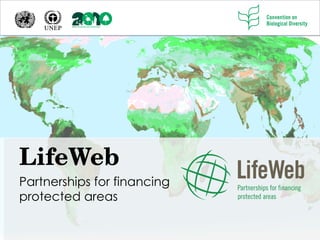
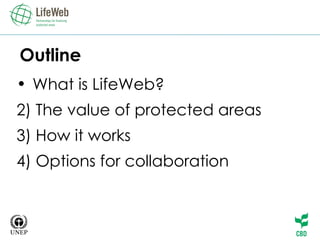

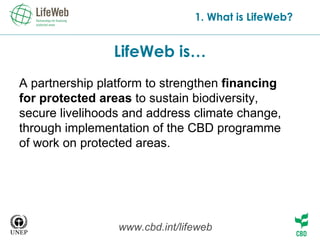


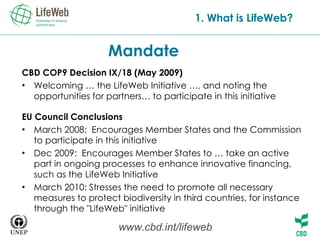
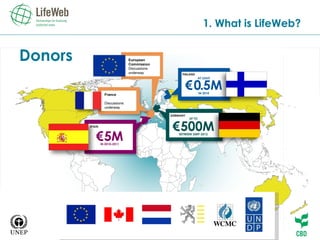

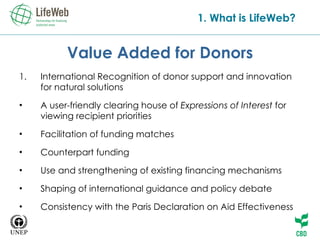
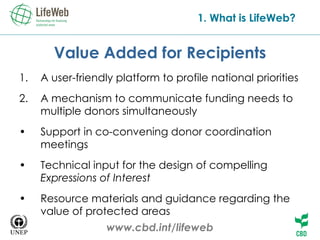
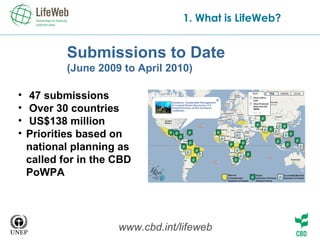
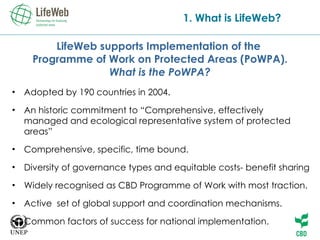
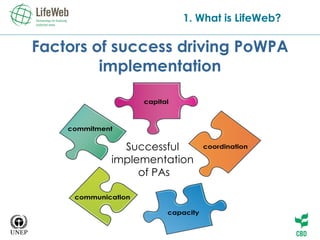
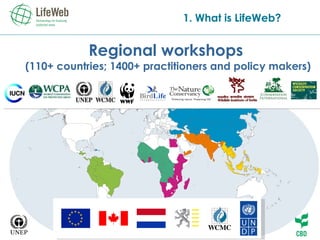
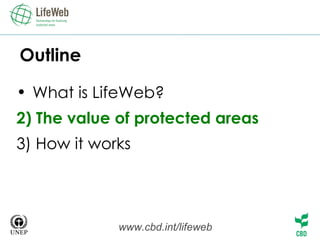
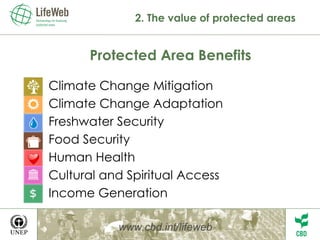
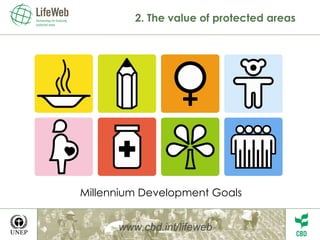
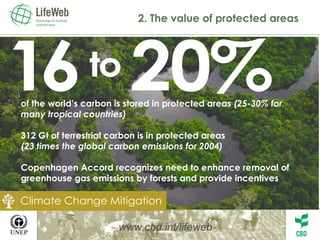


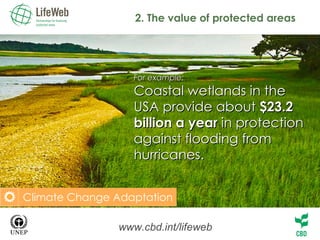
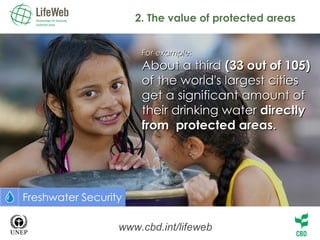
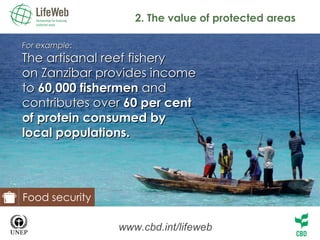
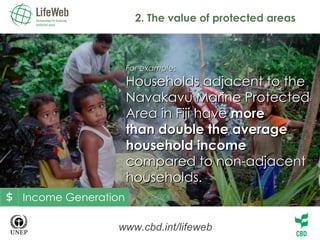
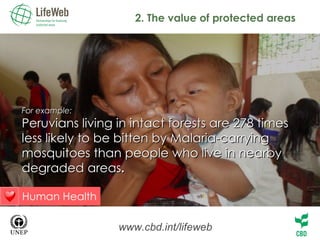

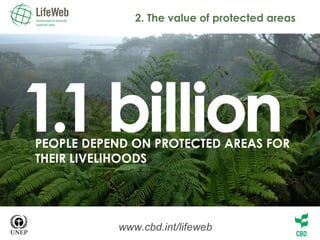
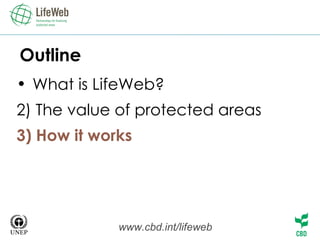

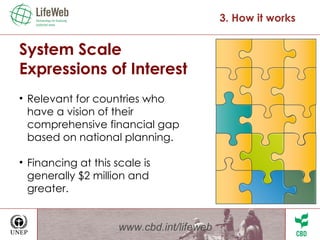
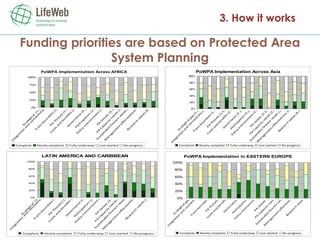
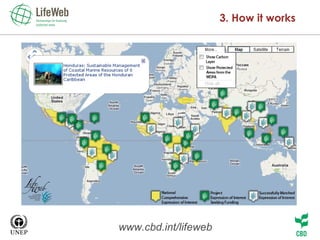
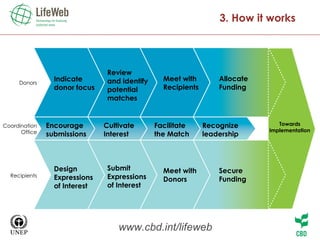

![For more information: www.cbd.int/lifeweb To contact us: [email_address] +1.514.287.8704](https://image.slidesharecdn.com/lifewebgeneral16-4-10-100723084250-phpapp01/85/LifeWeb-Presentation-36-320.jpg)